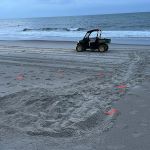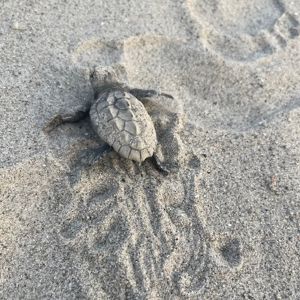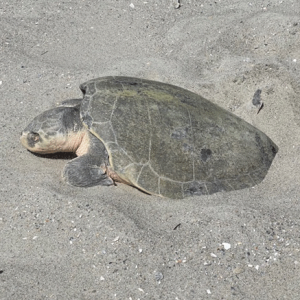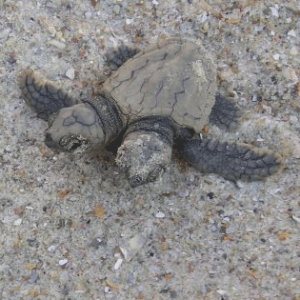

Our mission is to monitor, protect and preserve the sea turtle population of Holden Beach, NC. and to foster community-based conservation and education. Holden Beach Turtle Watch Program, Inc. is an all-volunteer, tax-exempt 501(c)(3) charitable organization that operates under the authority of the NC Wildlife Resources Commission.
How do we do this?
Starting on May 1st, volunteers begin a dawn patrol of the beach searching for turtle crawls and possible nests. Once a sea turtle crawl is found, a team of turtle patrol volunteers assembles at the crawl location to find the eggs.
If the nest is in an unsafe location, the nest will be carefully moved to a safer area on the beach. The nest site is then covered with a protective grating and marked off with stakes, ribbon and a warning sign. For the next 50-70 days of incubation the nest will be monitored for signs of an impending hatching.
At that time, turtle patrol members will start a nightly watch on the nest until all of the hatchlings are released. The nest is then opened and an inventory is taken to account for any unhatched or non-fertile egg and ensure that all live babies make it to the ocean.
This process is repeated with each and every nest. The season ends in October when the last nest hatches.

The Holden Beach Turtle Watch Program (aka Turtle Patrol) was founded in 1989 to monitor and protect the sea turtle population on Holden Beach. We do this through conservation of and education about the sea turtles that nest on our beach.
This all-volunteer nonprofit, tax-exempt 501(c)(3) charitable organization operates under the authority of the NC Wildlife Resources Commission ES Permit 25ST11.

Remembering and celebrating the life of our founder Judy Bryan who passed away February 23, 2023. Judy started the Holden Beach Turtle Watch Program out of her garage on Holden Beach in 1989. In 1996, she was named NC Conservationist of the Year for her work with the loggerhead turtles on our beach. She was known for her love of turtles and her untiring work for them. She started the turtle patrol with her husband Rick and 4-5 other volunteers. Originally it was very informal, however, she was a pioneer by establishing a turtle patrol with the NC Wildlife Resources Commission.
Early patrol member remember her storing the ATVs in the garage of her home on the west end of Holden beach. She was always ready to help anyone. The first year of the patrol they had just 17 nests. Friends miss her laugh and her smile. She was always up for fun. In the beginning everyone on the patrol wore several "different hats". She was the turtle "queen".
Visit our Newsfeed for many more stories of the sea turtles on Holden Beach.

Nest #1 on Holden Beach in 2021 was a record breaking nest. On May 8, 2021, it was the first nest laid in North Carolina that season and the first Kemp’s Ridley turtle to nest on Holden Beach since the HBPT has been keeping records. It was also the first nest to hatch in the state in 2021. The dedicated Turtle Patrol members under the direction of Project Coordinator and Assistant Coordinators took extra attention to this historic nest. 87 hatchlings were assisted into the ocean after an early morning boil. The nest was inventoried on July 17, 2021 and 90 egg shells were found.

The 2010 Leatherback Turtle Nest is the only nest on Holden Beach in the history of our program. She was over 6 feet from flipper to flipper and estimated to be over 900 pounds! She laid 70 eggs with about 30 decoy eggs which is normal for this species. What a rare and wonderful happening! We had 59 babies get to the water eggs which is a good hatch rate for a Leatherback.

Members of the Holden Beach Turtle Patrol found a unique baby among the hatchlings in the first nest that hatched on our beach in July. One of the babies that emerged during the "boil" was a conjoined (or Siamese twin) turtle. It had one shell but two heads. We believe this is the first conjoined turtle to be found in North Carolina. There have been reported incidences of conjoined turtles elsewhere in both sea turtles and fresh water turtles, but none that we know of in North Carolina. There is a report of a conjoined Green Sea Turtle living in a sea turtle education center in Mexico that is 10 years old.
After talking with our program coordinator it was decided that this turtle should be treated like all the others in this nest. The conjoined turtle walked down the turtle "trench" and went to the ocean like all of the other hatchlings. We were later instructed that in the future if we find such a unique turtle in one of our nests we should conduct the coordinator of the sea turtle protection program in the state before releasing the hatchling into the ocean. At that time a decision will be made whether the turtle should be released or taken to the sea turtle hospital or the aquarium for an undetermined amount of time. Staying at the hospital or aquarium will allow it to grow before being release and this may give it a better chance of survival despite it rare condition.
We hope that this special turtle is growing along with the other turtles in nest #1 from 2008 and we'll see her back on Holden Beach in 20 years or so.